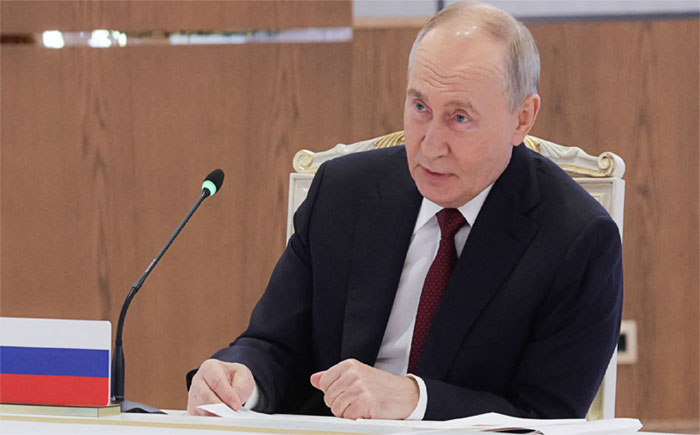
KYIV / WASHINGTON — A proposed peace summit between U.S. President Donald Trump and Russian President Vladimir Putin has dramatically collapsed, triggering immediate escalation on the battlefield. Just days after Moscow formally rejected a ceasefire proposal, Russian forces launched one of the largest combined drone and ballistic missile barrages on Ukraine this month, killing civilians and targeting critical energy infrastructure nationwide.
The shelved talks and the military escalation come amid an unprecedented financial maneuver in Europe: the formalization of a massive deal to supply Kyiv with 100 to 150 advanced Swedish fighter jets—a purchase that will be, in part, underwritten by billions in seized and diverted Russian state assets.
This convergence of failed diplomacy, intensified combat, and a major strategic weapons transfer marks the most dangerous turn in the conflict in months, cementing a new reality where the West is using Russia's own frozen wealth to fund a long-term strategy of Ukrainian air superiority.
The proposed summit between Presidents Trump and Putin in Budapest was intended to build on their earlier, inconclusive August meeting in Alaska. Hopes were high that Trump’s singular focus on ending the war might force a breakthrough.
However, a senior White House official confirmed the talks were put on hold after Russia sent a diplomatic "non-paper" that explicitly rejected Trump’s proposal for an immediate ceasefire based on freezing the current front lines. Russia’s counter-demand was maximalist: Ukraine must first surrender full control of the entire Donbas region.
President Trump, who reportedly did not want a “wasted meeting,” cancelled the summit and, in a sharp reversal, announced massive new sanctions against two of Russia’s largest oil companies, Rosneft and Lukoil. The sanctions were aimed at the core of Russia’s war financing apparatus.
Russian Foreign Minister Sergei Lavrov dismissed the ceasefire proposal, arguing it would simply allow Ukraine to rearm. Hours later, the Kremlin backed its rejection with force.
Overnight into Saturday, Russian forces launched a coordinated attack involving nine missiles—including deadly ballistic warheads—and 62 attack drones across Ukraine.
In Kyiv, at least two people were killed and a fire raged through a 13,000 square meter warehouse. Simultaneously, the Dnipropetrovsk region reported two dead and apartment buildings destroyed. Ukrainian officials confirmed the strikes were aimed at energy infrastructure to create a “humanitarian catastrophe... to coincide with winter.”
This military surge is a stark reminder that as long as the diplomatic path is blocked by Russia's maximalist territorial demands, Moscow will leverage military pressure to coerce Ukraine and its allies.
The most extraordinary development, however, lies in the long-term rearmament of Ukraine. In Linköping, Sweden, President Volodymyr Zelenskyy and Swedish Prime Minister Ulf Kristersson signed a Letter of Intent for the potential purchase of between 100 and 150 Saab Gripen E fighters.
The Gripen E, a highly agile, single-engine jet optimized for low-cost maintenance and quick take-offs from dispersed locations (including highways), is considered a superior fit for Ukraine’s wartime operational environment compared to heavier fighters. If fully executed, the deal would be one of Sweden’s largest-ever defense exports and more than double Ukraine’s existing combat air fleet.
The explosive financial detail is the funding mechanism: The multi-billion dollar deal is being structured to use confiscated Russian sovereign assets.
European governments, including Sweden, are now actively working to divert frozen Russian central bank reserves—assets seized under sanctions following the 2022 invasion—into structured financial funds. These funds would be used to underwrite the defense procurement for Kyiv, effectively forcing the Kremlin to pay for the very weapons being used to counter its aggression.
As one defense analyst noted, it is a “strategic inversion: Russian money fueling Ukrainian airpower and European industrial growth.”
The convergence of these events signals the end of ambiguity in the conflict.
The failure of the Trump-Putin summit underscores that the current path to peace is effectively blocked by irreconcilable demands. Russia will not accept a status quo ceasefire, and Ukraine will not cede territory.
The Gripen deal, financed by Russian money, represents a crucial pivot by Kyiv’s Western allies. It is a tacit acceptance that the war will be long, and that Ukraine’s modernization must be both substantial and paid for by the aggressor. The move bypasses the political complexities of Western domestic budgets and introduces a potent, long-term funding mechanism for Ukraine's defense industry.
Russia's response—the immediate, retaliatory missile and drone strikes—is a clear statement of defiance against both the political sanctions and the new financial warfare tactics. Moscow is using kinetic force to signal that it will continue to raise the human cost of the conflict as long as its geopolitical objectives remain unmet. The battlefield is now inextricably linked to the bank ledger.This has been The Red Hot Report from Pepper-Room. The news that bears it all.
What is your take on this? Air your view in the Comment Box.
www.pepperroom.com.ng #pepperroomnews #pepperroomng #pepperroom
Lagos, Nigeria.
+234 913 161 4181
+234 803 961 8550
+234 802 321 3873
info@pepperroom.com.ng
© 2025 | 🌶️Pepper-Room - Everything Loud, Wild, and Worth Talking About. | All Rights Reserved.
Pepper-Room is not responsible for the content of external sites.